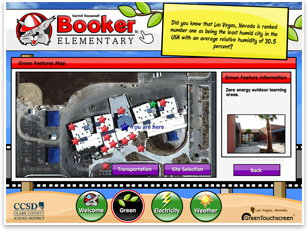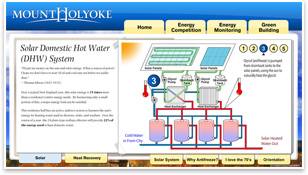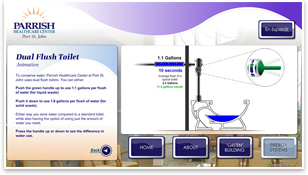Green at Your Fingertips
Small changes in behavior can yield dramatic results
by Heather Livingston
Contributing Editor
 How do you . . . get building occupants to think about how much energy and water they’re using? How do you . . . get building occupants to think about how much energy and water they’re using?
Summary: The GreenTouchscreen by Quality Attributes Software is a software-as-a-service (SaaS) application that delivers building performance and occupant environmental behavior through a Web-based kiosk. In addition to earning a LEED® innovation credit, the Touchscreen is delivering real change in occupant behavior and energy savings to building owners.
The trend to live lightly on the planet continues to gain traction worldwide, but there yet remain many individuals who don’t realize how seemingly minute decisions, such as turning off a desk lamp when not in use, can have a global impact. A visiting family member once chided me for the inconvenience of having to turn on my home computer router every time he wanted to check his e-mail, saying that it probably cost $2.00 a year to keep it on 24/7. Besides the obvious underestimate of the cost (I live in New England where power is much costlier than in the Mid-Atlantic state where he lives, plus I pay a premium for 100 percent “cow power”), I found that he missed the point entirely, which is that the energy consumption behind that router is more the problem than the minimal cost of keeping it on.
 Without even touching on the effects of global warming, using unnecessary electricity certainly contributes to the amount of pollution in the atmosphere, negatively affecting our health and driving up the cost of that energy because of increased demand. To teach building occupants about the impact of their daily environmental decisions, Quality Attributes Software created the GreenTouchscreen®. “GreenTouchscreen is designed to inform occupants of commercial, educational, and government buildings about ‘green’ buildings and their energy usage,” says Craig Engelbrecht, principal and chief marketing officer for Quality Attributes. Without even touching on the effects of global warming, using unnecessary electricity certainly contributes to the amount of pollution in the atmosphere, negatively affecting our health and driving up the cost of that energy because of increased demand. To teach building occupants about the impact of their daily environmental decisions, Quality Attributes Software created the GreenTouchscreen®. “GreenTouchscreen is designed to inform occupants of commercial, educational, and government buildings about ‘green’ buildings and their energy usage,” says Craig Engelbrecht, principal and chief marketing officer for Quality Attributes.
A SaaS-y learning tool
GreenTouchscreen is a Web-based interactive kiosk with modules that provide education and awareness about sustainability. The program draws on live and historical building data to create a powerful, experiential teaching tool. Being a SaaS application means the program is Web hosted, so there’s no software that needs to be downloaded and maintained by IT personnel. An added plus for the architect and owner is that the program is aligned with LEED to deliver an innovation credit.
The customizable content offers features as varied as a “green” feature map, LEED checklist, energy and water calculators, campus performance comparison, and useful occupant information like weather data, a building directory, event calendar, and donor recognition. Moreover, being Web based means interested parties can also view live dashboards from their computer.
 A case study A case study
A significant owner benefit of installing GreenTouchscreen kiosks is a quantifiable change in occupant behavior, thus reducing costs. The Atman Hospitality Group (AHG) currently is using the Touchscreen kiosks at its Gaia Napa Valley Hotel and Spa in American Canyon, Calif. The kiosks provide guests with information that allows them to be conscious of their energy and water use. Meters that provide electricity, water, and carbon-dioxide-use/emission data update guests on the status of the building’s efficiency. Historical-use charts compare Gaia Napa Valley to comparable hotels and equate the resulting savings. Guest room televisions are used to deliver data on the amount of electricity, water, and carbon dioxide they and the rest of the hotel is using and emitting. In addition, guests learn about the hidden systems such as solar power generation by viewing a solar panel system animation with real time electricity generation data.
“Many customers are jubilant and feel like they are a part of saving our environment,” said Wen Chang, president, AHG. Since installation of the GreenTouchscreen kiosks, the Gaia Napa Valley Hotel and Spa has seen energy use drop 26 percent and water 45 percent. “We attribute a direct correlation between the real-time feedback from the kiosks and the guests changing their habits, which saved us money,” he said.
| 

 How do you . . .
How do you . . . Without even touching on the effects of global warming, using unnecessary electricity certainly contributes to the amount of pollution in the atmosphere, negatively affecting our health and driving up the cost of that energy because of increased demand. To teach building occupants about the impact of their daily environmental decisions, Quality Attributes Software created the GreenTouchscreen®. “GreenTouchscreen is designed to inform occupants of commercial, educational, and government buildings about ‘green’ buildings and their energy usage,” says Craig Engelbrecht, principal and chief marketing officer for Quality Attributes.
Without even touching on the effects of global warming, using unnecessary electricity certainly contributes to the amount of pollution in the atmosphere, negatively affecting our health and driving up the cost of that energy because of increased demand. To teach building occupants about the impact of their daily environmental decisions, Quality Attributes Software created the GreenTouchscreen®. “GreenTouchscreen is designed to inform occupants of commercial, educational, and government buildings about ‘green’ buildings and their energy usage,” says Craig Engelbrecht, principal and chief marketing officer for Quality Attributes. A case study
A case study